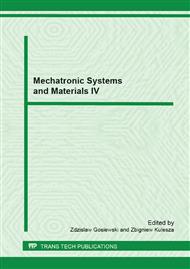[1]
J. Kejian, Z. Changsheng, T. Ming, A Uniform Control Method for Imbalance Compensation and Automation Balancing in Active Magnetic Bearing-Rotor Systems, Journal of Dynamic Systems, Measurements, and Control, 134 (2012), 13p.
DOI: 10.1115/1.4005279
Google Scholar
[2]
R. J. Prins, M. E. F. Kasarda, & S. C. Bates Prins, A System Identification Technique Using Bias Current Perturbation for Determining the Effective Rotor Origin of Active Magnetic Bearings. Journal of Vibration and Acoustics, 129(3), (2007).
DOI: 10.1115/1.2424976
Google Scholar
[3]
R. P. Jastrzebski, K. Hynynen, A. Smirnov, and O. Pyrhönen, Influence of the drive and dc link generated disturbances on an AMB control system. Electrical Review, 88(1a), (2012), 247-252.
Google Scholar
[4]
R.P. Jastrzebski, R. Pöllänen, O. Pyrhönen, A. Kärkkäinen, and J. Sopanen, Modeling and implementation of active magnetic bearing rotor system for FPGA-based control. ISMB10, (2006), CD proceedings.
Google Scholar
[5]
K. Hynynen, Broadband Excitation in the System Identification of Active Magnetic Bearing Rotor Systems. Dissertation, Acta Universitatis Lappeenrantaensis 446, LUT, Finland, (2011).
Google Scholar
[6]
R.P. Jastrzebski, Design and Implementation of FPGA-based LQ Control of Active Magnetic Bearings, Dissertation, Acta Universitatis Lappeenrantaensis 296, LUT, Finland, (2007).
Google Scholar
[7]
K. G. McConnell, Vibration Testing: Theory and Practice, first ed., John Wiley and Sons Inc., New York, (1995).
Google Scholar
[8]
T. Lindh, On the condition monitoring of induction machines. Dissertation, Acta Universitatis Lappeenrantaensis 174, LUT, Finland, (2003).
Google Scholar
[9]
S. Boyd, L. Vandenberghe, Convex Optimization, Cambridge University Press, (2004).
Google Scholar
[10]
J. Löfberg, YALMIP: A Toolbox for Modeling and Optimization in MATLAB. In Proceedings of the CACSD Conference, Taipei, Taiwan, (2004).
Google Scholar
[11]
R.P. Jastrzebski., R. Pöllänen, Centralized optimal position control for active magnetic bearings: comparison with decentralized control. Electrical Engineering, 91(2), (2009), 101-114.
DOI: 10.1007/s00202-009-0121-2
Google Scholar


